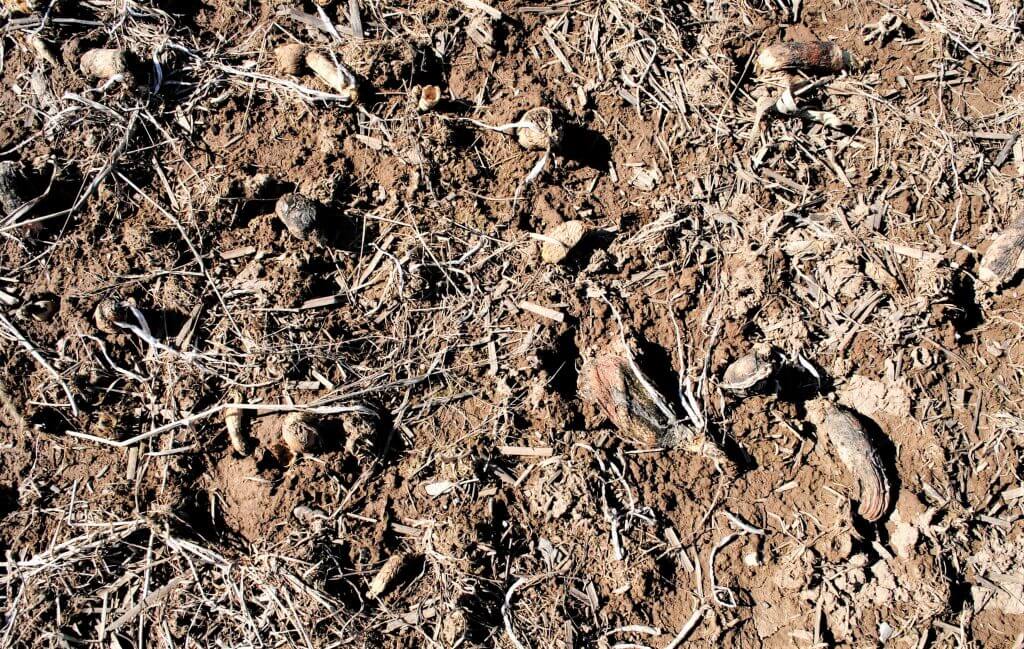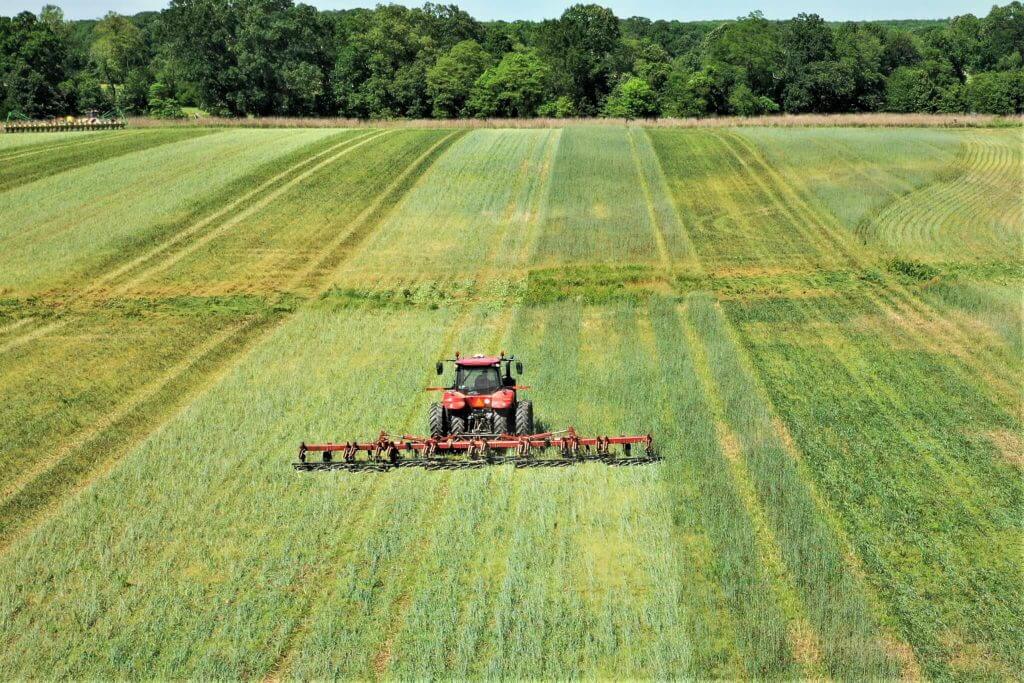Cover Crop Termination Options
Including cover crops in a cropping system provides farmers with several opportunities to control weeds.
- A preplant “burndown” herbicide may be applied before cover crop planting.
- Living cover crops suppress weeds by competing for light, nutrients, and space.
- Terminating cover crops can kill weeds (depending on termination method and specific weeds).
- After termination, cover crop mulch can suppress weeds in the following cash crop.
- Weed suppression from cover crops increases the later the cover crop is terminated; delaying termination until 10 to 14 days prior to cash crop planting (or terminating after planting the cash crop) often improves overall weed suppression compared to terminating three weeks or more before planting.
Cover crops are best used in tandem with other tactics, such as herbicides, narrow row spacing, and tillage to control weeds.
Consider termination options when choosing a cover crop
For specific cover crop termination recommendations for your area consult your local Extension office and state Extension materials.
Keep cover crop termination timing and methods in mind when choosing a cover crop. Farmers who are just beginning to experiment with cover crops or who have limited time and labor resources may consider growing cover crops that do not overwinter. While cover crops can help to suppress weeds, some may also become weeds if not successfully terminated. A cover crop that survives a termination attempt may compete with the cash crop planted into it and impact yields. If a cover crop that escapes termination is allowed to produce seed, those seeds can germinate and become weeds in subsequent cropping seasons.
Field activities that terminate a cover crop may also kill weeds present in the cover crop. Cover crop termination options can be broadly classified as winter-kill, mechanical, or chemical methods.
This video provides some important advice on selection and termination of cover crops when weed suppression is a key goal.
Termination Options
1) Winter-kill Termination
- Some common cover crops, including fall-planted oats and forage radishes, usually winter-kill (i.e. fail to survive the winter).
- Such cover crops typically require little to no time commitment for termination.
- These species can be quite effective in managing winter annual weeds, but have little to no impact on weeds germinating in the late spring or summer.
- If fall conditions allow a cover crop to set seed and seedlings emerge, or the cover crop survives the winter due to mild weather, it may be necessary to terminate the cover crop using another means before planting the cash crop.
- Winter-killed cover crops do not provide as many ecosystem services, such as weed control in the spring, as cover crops that overwinter and then continue growing in the spring.

2) Mechanical Termination Methods
Roller-Crimper
What is a roller-crimper?
A roller-crimper is an implement used to terminate some cover crops. This implement consists of a round drum with angled fins, often weighed down with water, that knock down a cover crop and damage or break the vascular system to kill the plants. Newer versions of the roller-crimper consist of two mechanisms: a smooth drum with a spring-loaded crimping device right behind. This design, though it has more components, provides the crimper with more force with which to effectively kill the cover crop. Learn more about the advantages and limitations of roller-crimping here.
- Roller-crimping is an option for many cover crop species.
- Out of all the mechanical methods listed, roller-crimping is the most successful for weed management as it turns the cover crop into a residue “mulch”.
- Timing is crucial for successful termination with a roller-crimper.
- Grass cover crops should be roller-crimped after they start flowering (anthesis).
- Legumes such as hairy vetch should be roller-crimped after they start to produce pods.
- When terminating mixtures, roller-crimp at the correct time for the latest-maturing species in the mixture unless multiple passes are possible.
- Depending on field conditions, the need to roller-crimp a cover crop at the correct stage for best control may delay cash crop planting.
- Many farmers are using roller-crimpers along with herbicides. In this situation, the main function of the roller crimper is to flatten the cover crop.

Tillage
- Tillage is a highly effective means of cover crop termination.
- Multiple tillage passes may be necessary, which reduces the benefits provided by cover crops.
- Cover crops with extensive root systems, such as annual ryegrass and perennial clovers, may require multiple tillage passes.
- Tillage breaks down and incorporates cover crop biomass into the soil, leaving no mulch to provide weed suppression.
Mowing
- Mowing is less effective than tillage or herbicides for cover crop termination.
- Mowing may leave an uneven layer of mulch, which decreases weed suppression capacity.
- Cover crops that grow back after mowing (e.g. grass species) may need to be mowed more than once for successful termination.
- Mowing will chop and shred cover crops into small pieces that allow them to break down rapidly, thus providing shorter periods of mulch cover for weed suppression.

3) Chemical Termination Methods
- Herbicides have more flexible timing windows than mechanical termination methods.
- However, herbicides may have rotational restrictions so choice depends on both cash and cover crop species in use.
- Most cover crops can be terminated with herbicides.
- Glyphosate readily controls grass cover crops, while tank mixtures (e.g., glyphosate + dicamba or 2,4-D) are needed to control legume cover crops.
- For cover crop species in which herbicide resistance has been documented (e.g., annual ryegrass), be prepared to use a different termination method or an effective herbicide that relies on a different site of action (SOA) to completely terminate the cover crop.
Cover Crop Termination Considerations
- Some potential cover crop problems can be foreseen and mitigated. Seed scarification prior to hairy vetch planting has been demonstrated to destroy hardseededness. Breeding efforts are underway to decrease the amount of hard seed in hairy vetch cultivars.
- Brassicas that overwinter, such as rapeseed, can be difficult to control with herbicides. Be prepared to mechanically terminate such cover crops, or choose a grass or legume instead.
- A number of factors can reduce herbicide effectiveness, including weather conditions in the spring and herbicide tank mixtures. Be sure to scout the field after termination to ensure the cover crop is successfully terminated.
- Choose only certified cover crop seed from reliable sources to avoid introducing new weeds into the field via contaminated seed. Know what you are buying. Annual ryegrass, perennial ryegrass, and Italian ryegrass can interbreed and are sometimes confused in the trade but have distinct traits.
Many termination methods are dependent on timing. If field conditions such as excess spring rain delay or prevent timely cover crop control, consult your local Extension office for termination options and recommendations for addressing the effects of delayed cover crop termination. For example, slightly more N may be applied as a starter in corn to balance the effect of large amounts of cereal rye biomass on soil N levels.
Bottom line: it is crucial to successfully terminate a cover crop. Have a strategy in mind before you plant your cover crops. More than one termination method or pass through the field may be needed if the first method or pass fails.
Funding
This material is based upon work supported by the Natural Resources Conservation Service, U.S. Department of Agriculture, under award #NR183A750010C002. Any opinions, findings, conclusions, or recommendations expressed in this publication are those of the author(s) and do not necessarily reflect the views of the U.S. Department of Agriculture. USDA is an equal opportunity provider and employer.
Authors
- Victoria Ackroyd (USDA-ARS, Beltsville, MD)
- Mark VanGessel (University of Delaware)
- Claudio Rubione (University of Delaware)
- Kara Pittman (Virginia Tech)
- Michael Flessner (Virginia Tech)
Resources
- Curran, W. 2013. Cover crop rollers for Northeastern grain production. Penn State Extension resource. Available at: https://extension.psu.edu/cover-crop-rollers-for-northeastern-grain-production Accessed 16 April 2019.
- Lingenfelter, D and W Curran. 2015. Special cover crop control considerations. Penn State Extension resource. Available at: https://extension.psu.edu/special-cover-crop-control-considerations Accessed 16 April 2019.
- Mirsky, SB, JM Wallace, WS Curran, and BC Crockett. 2015. Hairy vetch seedbank persistence and implications for cover crop management. Agron J 107: 2391-2400.
- Mischler R, SW Duiker, WS Curran, and D Wilson. 2010. Hairy vetch management for no-till organic corn production. Agron J 102: 355-362.
- Palhano, MG, JK Norsworthy, and T Barber. 2018. Evaluation of chemical termination options for cover crops. Weed Tech 32: 227-235.
- University of Maryland Extension. 2014. Offing cover crops for weed suppression: Featuring the roller crimper and other mechanical contraptions. Available at: https://extension.umd.edu/learn/offing-cover-crops-weed-suppression-featuring-roller-crimper-and-other-mechanical-contraptions
For more information
Disclaimer: Reference to commercial products or trade names does not imply endorsement or bias against those not mentioned.


























































































